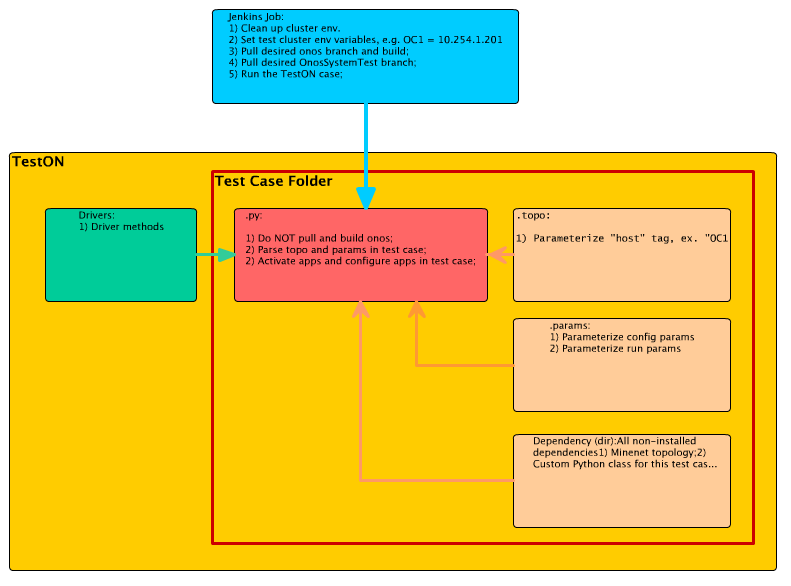Due to a ransomware attack, the wiki was reverted to a July 2022 version. . We apologize for the lack of a more recent valid backup.
A few quick tips to get started contributing to OnosSystemTest:
- Subscribe to the System Testing mailing list <onos-test@onosproject.org>. All mailing lists can be found here.
- Sign up for an account on onosproject.org to be able to commit test codes to gerrit.onosproject.org.
- If you are not familiar with Gerrit workflow, check out this tutorial: Gerrit Workflow for System Test Development.
- Check out our guides about the TestON framework: System Testing Guide.
Fundamentals on Authoring a Test Case
Because we are targeting all tests to be automated in a Continuous Integration (CI) environment, there are several fundamental principles that we adhere to when writing test cases and driver files:
- Portability - allow the test case to be run in other similar test environments, as well as merging community contributed tests into our production environment.
- Stability - the test must handle various environment (e.g. response time of starting ONOS on VMs vs. on Bare Metals); test case must have stability in passing or failing results.
- Clarity - strive to make Python cases simple to comprehend.
- Debugging - use logging capabilities liberally to catch all cases of exceptions, and to ensure test failures don't go silently.
In order to achieve these objectives, it is essential to have a good understanding of the Jenkins - TestON interactions and abstractions in running a test case. The following diagram illustrates the interaction and abstraction of TestON and Jenkins.

TestON Scripting General Guidelines:
- Pre-requisites and testbed environment setting - should be set manually, and/or with CI framework (i.e. through Jenkins jobs):
- First Time Setup:
- TestStations:
- should have a root account of "sdn" (password: rocks) to run TestON cli (so all hosts in the test infrastructure has the same sdn/rocks credential)
- should be able to login to all nodes specified in the cell. See this guide to setup ssh keys.
- "ONOS Bench" and cells: set up per "ONOS from Scratch".
- Mininet (OCN) host: set up per "Mininet Walkthrough".
Note: it is possible to run "TestStation", "onos Bench" and "Mininet" on the same host, with .topo file set up accordingly.
- TestStations:
- General Steps:
- Clean up TestON and Mininet before each test run.
- Set OnosSystemTest version, and update OnosSystemTest by typing: "git pull OnosSystemTest" from gerrit.onosproject.org.
- Set ONOS version, and update ONOS by typing: "git pull onos" from gerrit.onosproject.org.
- Compile/Build ONOS.
- Set up ONOS Java Virtual Machine (JVM) related configurations if the default configuration is not desirable.
- Run test cases. See scripting guidelines below.
- Optional:
- Run post-test tasks, such as:
- Data storage
- Result publishing
- Teardown by uninstalling ONOS and cleaning up Mininet.
- Run post-test tasks, such as:
- OnosSystemTest/TestON Script should perform in:
- Test suite naming, see Test Plans.
- README file
- Should describe the test topology to run the default test case.
- Should explain the main goal of the test.
- Provide any additional requirements needed to run the test.
- testname.params
- Use environment variable names to reference to components - no static IP's.
- Move any hardcoded values to this file - e.g. sleep times, counters, file names... etc.
- If any modifications need to be made to the test, it should be done in this file.
- testname.topo
- Use environment variable names to reference to components - no static IP's.
- Leave out any passwords for the login information - Password-less login should be setup.
- Use environment variable names to reference to components - no static IP's.
- testname.py
- Log ONOS version/commit.
- Set prompt, terminal type.
- Handle test case dependencies.
- Explicit ONOS cell creation and setting.
- Explicit activation of bundles/apps.
- Test case specific app configurations for non-default values - cell apps should be specified in the params file.
- Test dependencies, Mininet topologies, and helper functions should be stored in the Dependency directory located in the test directory.
- Test log should log the relevant config information - Log is cheap; be as verbose as possible to help the debugging process.
- Avoid static reference to paths, files - put any static references in the .params file.
- Check and log summary of onos exceptions, errors, warnings - Ideally, this should be done after each test case/
- Handling of Test results - write to test log and /tmp file for post-test processing purposes - Try to assert on every test result so that it can be shown on the wiki.